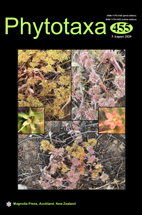Abstract
Aspergillus subgenus Polypaecilum contains species with solitary phialides instead of aspergilli and conidia occurring in chains, heads, or singly. Most species in this subgenus are xerotolerant or halotolerant and are widely distributed in house dust and saline environments. Some subgenus Polypaecilum members like Aspergillus caninus and A. chlamydosporus grow well at 37 °C and were associated with mycoses in canines. In the present study, three strains isolated from farmland soil were assigned in subgenus Polypaecilum based on multilocus phylogenetic analyses but showed low sequence similarity with existing species. They were named as a new species, Aspergillus telluris sp. nov.. Aspergillus telluris falls into the A. caninus and A. chlamydosporus clade. Morphologically it is similar to A. chlamydosporus by production of subglobose, pyriform, ellipsoidal conidia and globose to subglobose chlamydospores. This is also the first report of Aspergillus subgenus Polypaecilum species in China.

